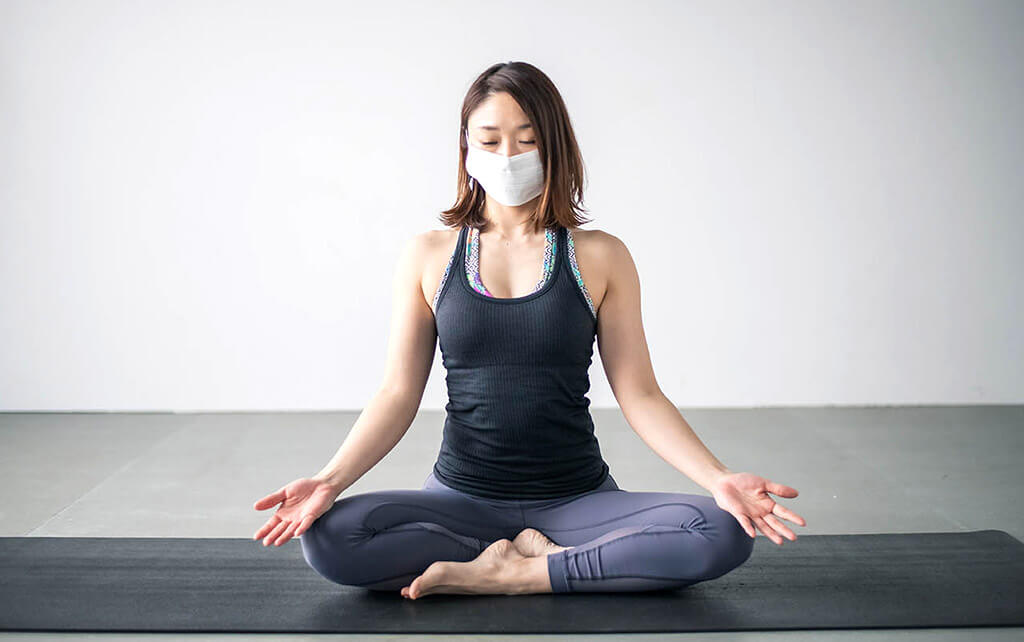The club is open, and we’re happy to welcome you back! While we’ve already talked about the new protocols to keep our members safe, we’re sure you still have questions. Masks have been one particular point of confusion. Is it safe to exercise in a mask? How can you make mask-wearing more comfortable while exercising? According to health and exercise experts, these are all valid questions. Luckily, they’ve also provided some answers.
The importance of masks
Think about the last time you stood outside on a cold night and exhaled. As the cold air hits your warm breath, the moisture hangs suspended in the air like a cloud. Whether or not we can see it, every exhalation contains this same moisture. Also known as respiratory droplets, this moisture is how novel coronavirus is transmitted.
That’s why the Centers for Disease Control and Prevention recommend face coverings whenever we’re in public. That recommendation includes outdoor spaces, like parks and playgrounds, and indoor spaces, including gyms.
Masks in public are especially important because people exhibiting no symptoms can still be infected and spread the virus. The primary function of masks (especially cloth and non-medical grade masks) is to trap droplets and help reduce the spread of the virus by people who have COVID-19 but don’t realize it.
But it only works if everybody participates
As Dr. Daniel Durand noted in a recent interview with UnderArmour, “I think of wearing face masks as a team sport because it requires the participation of each team member to be successful.” When everybody wears masks together, especially in close-contact environments like a gym or group exercise class, it can be an effective way to reduce the spread of COVID-19. By wearing our masks, we’re not just protecting ourselves. We’re protecting every member of our community.
With that said, there are a few things to keep in mind when choosing the right mask for your exercise routine:
Not all masks are created equally
First, make sure your mask fits well. A proper fit should keep your mouth and nose covered at all times, not pinch around the head or ears, and be snug around your nose. Like any other type of athletic apparel, your mask should also be made of moisture-wicking material (think spandex or polyester).
You’ll also want to balance breathability with safety. For example, medical-grade coverings like N95 masks have strong filters. Because they prioritize safety—and filter 95% of particles—they’re not ideal for physical activity. High-performance athletic fabrics are generally more breathable. They also stretch better than cotton or linen face masks.
Some types of exercise are better for mask-wearing
Next, you’ll want to plan your exercise around whether or not you’re wearing a mask. For example, high-intensity interval training will likely be more difficult while wearing a mask. Instead, you may want to stick to exercises like weight training, cycling, or running.
Some exercises and exercise spaces will also be higher risk than others. As Dr. Durand notes, “[without masks] indoor exercise activities like dance aerobics classes carry a fairly high risk, because when you have several people in a room for a group fitness class, and they’re breathing heavily, there’s going to be lots of respiratory droplets projected into the air that is being recirculated around the gym.”
Do I need to wear my mask even if I’m exercising outside?
Health experts—including Dr. Durand—agree that location is less important than proximity. Whether you’re inside or outside, it’s all about maintaining six feet of space. For example, if you’re running outdoors and know you won’t encounter any other exercisers, you probably don’t need a mask. But running on a busy trail or crowded beach is a different story.
But is it safe to exercise in a mask?
According to experts, yes. For most people. Those with certain health conditions may want to skip the mask and practice strict social distancing instead. Examples of these conditions include chronic obstructive pulmonary disorder (COPD), asthma, bronchitis, cystic fibrosis, pulmonary fibrosis, and other conditions that affect the lungs or heart.
Still, you’ll want to monitor yourself and your body while exercising in a mask. Watch out for any dizziness, lightheadedness, or shortness of breath. If you experience any of these symptoms, take a break and find a safe, socially-distanced space to recover. Just like any new exercise routine, start slow and acclimate yourself to exercising in a mask. Starting each workout with a five-minute masked jog can help you build up your tolerance.
Our mask policy
Here at the club, we’re asking our guests to protect each other by wearing masks when they enter the club, spend time in or walk through a communal space, or work out within 6 feet of other members. If you’re able to maintain appropriate social distancing during your workout, you can remove your mask for the duration. As an added safety precaution and in response to local and state mandates (as well as recommendations from the CDC and Santa Barbara County’s Public Health Department), we’ve shifted our workout spaces outside for better air circulation.
As policies and recommendations continue to evolve, one thing has stayed the same: our commitment to keeping you and your family safe. Every single one of us has a role to play as we navigate the novel coronavirus together. We appreciate your cooperation as we continue to hone our protocols per CDC guidelines.
